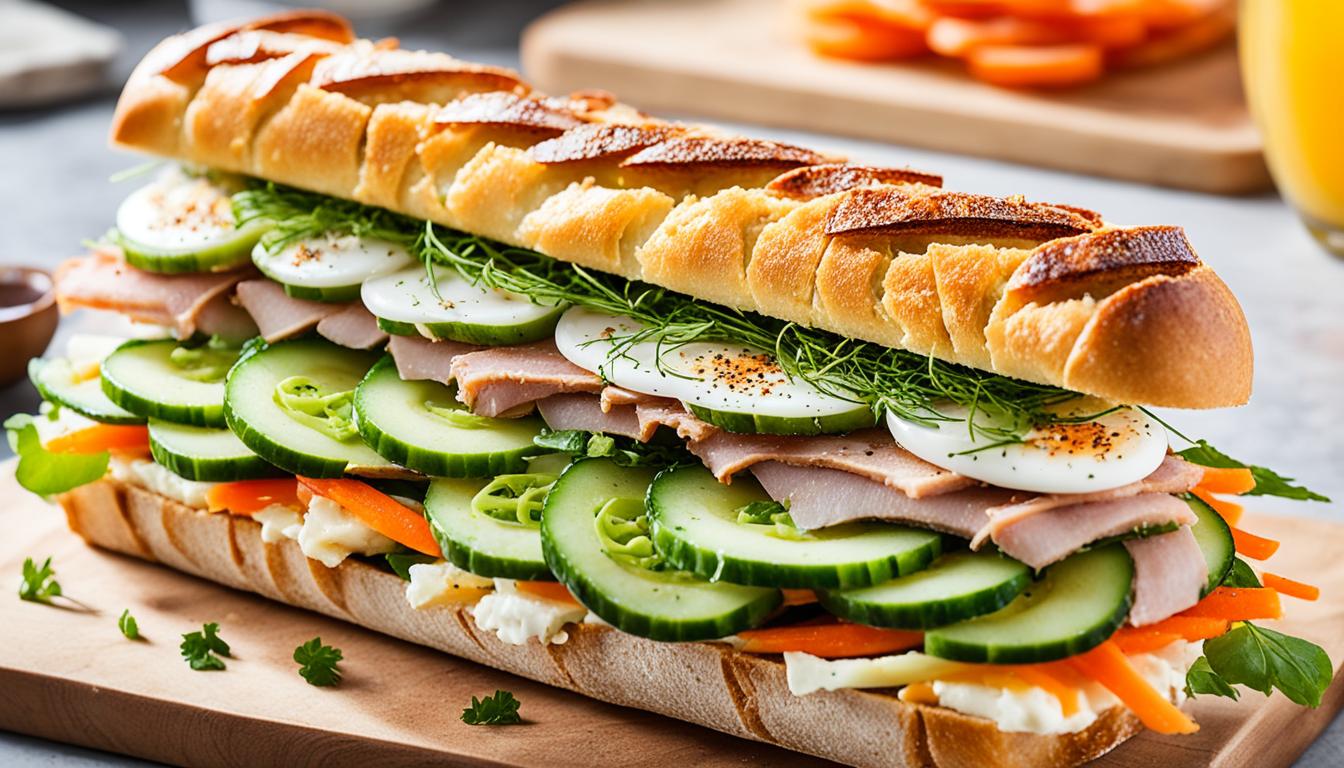Have you ever wondered what makes a classic Vietnamese banh mi sandwich so irresistible? Is it the combination of flavors? Or perhaps the secret lies in the unique blend of Asian and European ingredients? Today, we’re diving deep into the world of banh mi to uncover the secrets behind this mouthwatering street food dish.
The banh mi sandwich is a culinary masterpiece that originated from the fusion of Vietnamese and French cuisines during the French colonization of Vietnam in the 1860s. It’s a delightful blend of a crispy baguette, seasoned meats or meat alternatives, and an array of vegetables and herbs.
But what sets an authentic banh mi sandwich apart from the rest? It’s the attention to detail and the use of high-quality ingredients. By making your own homemade banh mi, you have the freedom to customize the filling and create a flavor combination that suits your taste buds.
Whether you’re a banh mi fanatic or someone looking to explore new flavors, this article will guide you through the history of banh mi, reveal the secrets behind its unique flavors, and provide you with an authentic egg and pate banh mi recipe that will transport your taste buds to the streets of Vietnam.
Key Takeaways:
- The banh mi sandwich is a classic Vietnamese street food dish that combines Vietnamese and French culinary traditions.
- The key to a great banh mi sandwich is using high-quality ingredients and attention to detail.
- Making a homemade banh mi sandwich allows you to customize the filling and create a unique flavor combination.
- The banh mi sandwich can be enjoyed for breakfast, lunch, or dinner.
- Stay tuned to learn the fascinating history of banh mi and discover an authentic egg and pate banh mi recipe.
The History of the Banh Mi Sandwich
The banh mi sandwich has a rich and intriguing history that brings together the culinary traditions of Vietnam and France. Introduced by French colonizers in the 1860s, the banh mi’s origins can be traced back to the French influence on Vietnamese cuisine.
Initially, sandwiches in Vietnam were inspired by classic French fillings like ham and butter. However, as the sandwich evolved over time, it developed a unique identity in the Vietnamese street kitchen.
Events such as World War I and the Vietnam War played a significant role in shaping the banh mi sandwich. Vietnamese bakers adapted the baguette by using a mixture of rice flour and imported wheat to create a more affordable version.
During the Vietnam War, the influx of refugees brought a diverse range of flavors and ingredients to the banh mi. This culinary fusion further contributed to the sandwich’s popularity and variety.
In the 1980s, when the banh mi arrived in California, it quickly gained popularity in the United States. Today, it is cherished as a beloved street food dish enjoyed by people around the world.
Explore the fascinating history of the banh mi sandwich and discover how this delightful fusion of Vietnamese and French culinary influences has captured the hearts and palates of food enthusiasts everywhere.
Vietnamese street kitchen
The banh mi sandwich is a true testament to the vibrant and dynamic nature of Vietnamese street cuisine. It reflects the creativity and resourcefulness of Vietnamese cooks who transformed a French staple into a distinctively Vietnamese delight.
French influence on banh mi
The French colonization of Vietnam left an indelible mark on the country’s culinary landscape. The introduction of baguettes to Vietnam paved the way for the birth of the banh mi sandwich, combining French baking techniques with Vietnamese flavors and ingredients.
Banh mi origins
The origins of the banh mi sandwich lie in the melding of Vietnamese and French culinary traditions. From its humble beginnings as a simple sandwich with French-inspired fillings, the banh mi has evolved into a beloved street food icon that showcases the diverse and exciting flavors of Vietnam.
How to Make an Authentic Egg and Pate Banh Mi
Interested in making banh mi at home? We’ve got you covered with our authentic egg and pate banh mi recipe. Follow these simple steps to create a delicious and flavorful Vietnamese sandwich right in your own kitchen.
To start, marinate your pork tenderloin in a mixture of lemongrass, fish sauce, and other aromatic spices. This will infuse the meat with mouthwatering flavors. Thinly slice the pork and grill or barbecue it until it develops a caramelized crust and a tender texture.
Next, prepare the pickled carrots and daikon radish. Combine rice vinegar, sugar, and salt in a brine mixture, and let the vegetables marinate for at least 30 minutes. This quick pickling process adds a tangy and refreshing element to your banh mi.
Now it’s time to assemble your banh mi sandwich. Toast Vietnamese baguettes or use bolillos or dinner rolls as a substitute for a similar texture. Create a creamy spread by mixing mayonnaise, soy sauce, and garlic powder. Spread this garlic mayo on both sides of the bread. Layer a generous amount of the pickled vegetables, followed by slices of grilled pork. Finally, top it off with fresh cilantro to add a burst of herbaceous goodness.
Feel free to customize your egg and pate banh mi with additional toppings such as Sriracha sauce, a squeeze of lime juice, or sliced jalapenos, according to your taste preferences. Enjoy this homemade banh mi sandwich as a flavorful and satisfying meal for breakfast, lunch, or dinner. Bon appétit!
